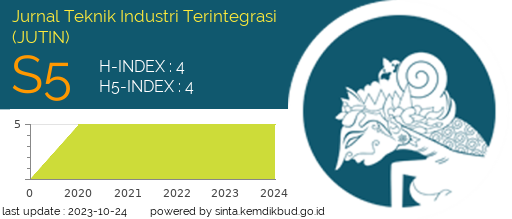Optimasi Setting Mesin Cutting roll Menggunakan Design off Experiment (Studi Kasus: CV. Surya Gemilang)
DOI:
https://doi.org/10.31004/jutin.v7i2.30164Keywords:
Design of Experiment, Defect, Full Factorial Design, List webbingAbstract
The economic growth of the manufacturing sector in Indonesia is increasing rapidly every year. One that contributes to this economic growth is the textile industry. Along with the growth that occurs, textile companies strive to achieve a more effective and efficient production process, namely by reducing defective products or defects from the production carried out. CV. Surya Gemilang is a company that faces similar problems. CV. Surya Gemilang is a company engaged in the manufacturing industry sector, one of whose products is textile products, namely list webbing. list webbing is a superior product from CV. Surya Gemilang which has collaborated with 4 companies with requests for up to 15 rolls per month per company, where each 1 roll contains approximately 60 list webbing. In the production process list webbing still has a defect value produced after a fairly large production process. One of the factors that cause defective products to occur is the machine used, the machine used for the production of list webbing is a cutting roll machine. For this reason, it is necessary to conduct research using the Design of Experiment method using a Full Factorial Design approach with 2 replications. The factors used are roll rotational speed (rpm), feeding speed (rpm), and horizontal moving blade speed (rpm). This study aims to find factors that have a significant effect and find the optimal cutting roll machine settings to reduce the defects produced. From the results of this study, the factors that have a significant effect are the factor of feeding speed, horizontal speed, and the interaction between the factors of rotating speed and feeding speed and the optimal cutting roll machine settings are rotating speed with a level of 50 rpm, feeding speed with a level of 125 rpm and horizontal speed with a level of 50 rpmReferences
Laju Pertumbuhan PDB Seri 2010 (Persen), 2024. (2024, May 6). Badan Pusat Statistik. https://www.bps.go.id/id/statistics-table/2/MTA0IzI=/pertumbuhan-ekonomi--triwulan-i-2024.html
Ahmad, Salomon, L. L., & Jessica. (2018). Desain Eksperimen Untuk Meningkatkan Kualitas Kekuatan Produk Dengan Pendekatan Analisis Desain Faktorial. Jurnal Ilmiah Teknik Industri, 6(3), 1–12.
Al Aidhi, A., Ade, M., Harahap, K., Rukmana, A. Y., Palembang, S. P., & Bakri, A. A. (2023). Peningkatan Daya Saing Ekonomi melalui peranan Inovasi. Jurnal Multidisiplin West Science, 2(02), 118–134. https://doi.org/10.58812/jmws.v2i02.229
Asshidiqi, Z., Wahyudi, & Rachman, F. (2018). Analisa Nilai Pertambahan Panjang Material ST37 Pada CNC Mesin Bending TRUMPF TruBend 5050 Menggunakan Metode Full Factorial. 1–4.
Gumiwang Kartasasmita, A. (2023, July 3). Menperin: PMI Manufaktur Juni 2023 Naik Tinggi, Tapi Industri Tekstil Masih Menderita. Kementrian Perindustrian Republik Indonesia. https://www.kemenperin.go.id/artikel/24184/Menperin:-PMI-Manufaktur-Juni-2023-Naik-Tinggi,-Tapi-Industri-Tekstil-Masih-Menderita?
Kirana, N. (2023). Analisis Pengaruh Perendaman Komposit Serat Daun Suji Dengan Persentase Serat 15%, 20% dan 25% Pada Pengaplikasian Panel Panjat Dinding.
Ladou, J. S., Adianto, H., & Susanty, S. (2015). Usulan Kombinasi Terbaik Faktor Yang Berpengaruh Terhadap Cacat Produk Botol Plastik 600 Ml Menggunakan Metode Full Factorial 2K Di PT. X.
Laricha Salomon, L., Kosasih, W., & Oscar Angkasa, S. (2015). Perancangan Eksperimen untuk Meningkatkan Kualitas Ketangguhan Material dengan Pendekatan Analisis General Factorial Design (Studi Kasus: Produk Solid Surface). Jurnal Rekayasa Sistem Industri, 4(1), 1–7.
Montgomery, D. C. (2017). Design And Analysis Of Experiments (J. Wiley & Sons, Eds.; 9th ed.).
Muriana, S. (2023). Analisis Komposit Berpenguat Serat Tandan Sawit Terhadap Kekuatan Tarik dan Kekuatan Impak.
Napitupulu, M. E., & Hati, S. W. (2018). Analisis Pengendalian Kualitas Produk Garment Pada Project In Line Inspector Dengan Metode Six Sigma Di Bagian Sewing Produksi Pada PT Bintan Bersatu Apparel Batam. Journal of Applied Business Administration, 2(1), 29–45.
Rahma, N. D., Putro, G. M., Sadi, S., & Khanan, M. S. A. (2019). Eksperimen Optimasi Kekerasan Paduan Kuningan dengan Metode Desain Faktorial 33. OPSI, 12(2), 96. https://doi.org/10.31315/opsi.v12i2.3150
Safira, S. D., Retno, W., & Damayanti, S. T. (2022). Analisis Defect Produk dengan Menggunakan Metode FMEA dan FTA untuk Mengurangi Defect Produk (Studi Kasus: Garment 2 dan Garment 3 PT Sri Rejeki Isman Tbk).
Sianturi, T. A. (2018). Efek Variasi Tekanan Nozel Terhadap Emisi Gas Buang Kenderaan Roda Empat 2300cc. JURNAL DARMA AGUNG, XXVI, 1–8.
Winarni, S., Sunengsih, N., & Anugrah, R. I. (2019). Penerapan Desain Fractional Factorial dalam Menentukan Faktor Berpengaruh pada Eksperimen Pelindian Konsentrat Galena (PBS). 19(2), 83–92.
Downloads
Published
How to Cite
Issue
Section
License
Copyright (c) 2024 Achmad Farikhin Ramadhani, Benazir Imam Arif, Huki Chandra

This work is licensed under a Creative Commons Attribution-ShareAlike 4.0 International License.



